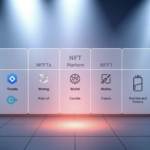Now Reading: Discover AI Powered Crypto Derivatives Trading Platforms
- 01
Discover AI Powered Crypto Derivatives Trading Platforms
Discover AI Powered Crypto Derivatives Trading Platforms

Explore how machine learning and advanced algorithms automate parts of crypto trading so users can define strategies, backtest with historical data, and monitor markets around the clock.
The guide summarizes leading bots and services — like 3Commas, Cryptohopper, Coinrule, Shrimpy, Bitsgap, TradeSanta, HaasOnline, and Pionex — and compares how they link to exchanges such as Binance Futures, OKX, Bybit, Deribit, CME, Coinbase Derivatives, dYdX, Kraken, Bitget, and Aevo.
We focus on derivatives venues and automated systems that execute trades reliably while keeping U.S. rules and risk controls in mind.
Expect clear comparisons of features, fees, execution tools, and support, plus notes on liquidity, margin mechanics, and product coverage (perps, futures, options). This roundup highlights backtesting, order management, and required human oversight so traders can match tools to goals.
Key Takeaways
- Machine learning bots automate and monitor markets but need human risk controls.
- Top services vary by supported exchanges, fees, security, and customization.
- We compare features like backtesting, execution routing, and fee mechanics.
- Choice of venue depends on liquidity, product coverage, costs, and U.S. eligibility.
- Include both centralized and decentralized options and practical tool stacks.
What “AI-powered” means for crypto derivatives today
Modern models and algorithmic systems turn raw market data into actionable rules for perpetual swaps, dated futures, and options. That change lets strategies run continuously, spot short windows of opportunity, and enforce risk limits without emotional bias.
How machine learning and advanced algorithms inform perps, futures, and options
Machine learning models and advanced algorithms process price trends, volume, and order-book signals to produce probabilistic entries, exits, and hedge ideas. These signals feed rule sets that backtest over historical data so users can refine strategies before live use.
From signals to execution: bridging analytics, automation, and risk controls
Analytics platforms translate signals into automated order workflows tied to exchanges like Binance, Coinbase, and Kraken. Execution quality matters: slippage and latency shape real results, especially in perps and options.
- Tools: backtesting, alerting, and position rules keep strategies aligned with limits.
- Risk: margin APIs, max-loss caps, take-profit ladders, and circuit breakers prevent cascading losses.
- Data: high-quality feeds and robust execution are essential for models to adapt to market conditions.
Search intent and who this roundup is for
This guide helps traders and analysts decide which automation and exchange options best match their goals and risk tolerance.
It targets active and systematic traders, analysts evaluating trading bots, and investors researching venues and tools. New users will see how bots can simplify workflows. Experienced users can focus on APIs, latency, and liquidity.
Search intent: readers want to know which services support derivatives workflows, which features matter, and how fees, support, and data quality affect outcomes.
- U.S. readers: look for CFTC/NFA venues, clear disclosures, and compliance paths like CME and Coinbase Derivatives.
- Evaluation checklist: liquidity, security, fees, funding mechanics, coverage, UX, and monitoring tools.
- Practical tip: shortlist by eligibility and the specific features you will use.
| Audience | Key Need | Decision Driver | Example Focus |
|---|---|---|---|
| New users | Ease of use | Onboarding, templates | Simple bots, strong support |
| Active traders | Execution quality | APIs, latency, liquidity | Deep books, low fees |
| Analysts & funds | Compliance & coverage | Regulated access, reporting | CME, Coinbase, Kraken |
How we evaluated platforms and tools
Each provider was assessed on a repeatable scorecard that links technical metrics to trader needs. Scores weight Liquidity most, then Security, Coverage, Costs, UX, and Support so comparisons match real market impact.
Liquidity, security, costs, coverage, UX, and support: a balanced scorecard
Methodology weights: Liquidity 30%, Security 25%, Coverage 15%, Costs 15%, UX 10%, Support 5%.
- We prioritize fills and depth that affect execution for active trading.
- Security assessment uses disclosures, incident history, and API scopes.
- Fees and feature sets are reconciled with typical strategy turnover.
Why backtesting, paper trading, and risk alignment matter
Backtesting using historical data validates ideas before capital is at risk. Paper trading and controlled experiments reduce costly mistakes during early iterations.
Data sources and U.S. relevance
We used official docs, fee schedules, API references, status pages, and hands-on reviews through September 2025. U.S. users must verify CFTC/NFA eligibility and onboarding for CME and Coinbase Derivatives.
| Criteria | Why it matters | Practical check |
|---|---|---|
| Liquidity (30%) | Affects slippage and execution quality | Depth, bid/ask spreads, 24h volume |
| Security (25%) | Protects capital and data | Audit reports, insurance, incident history |
| Costs & Coverage (30% combined) | Fees and product fit change P&L | Fee tiers, funding rules, product lists |
Centralized leaders for derivatives: where AI-driven strategies thrive
For many systematic traders, major exchanges offer the execution quality and margin tools needed to run automated strategies.

Binance Futures, OKX, and Bybit deliver the depth and APIs that support high-frequency workflows. Binance offers wide perp listings, deep books, robust APIs, and portfolio margin.
OKX balances perps, dated futures, and options inside a unified account, which helps users test multi-product strategies. Bybit provides broad perp markets, demo environments, and OpenAPI for developers.
Options and regulated access
Deribit is the benchmark for BTC/ETH options liquidity with deep strikes and maturities. For U.S. access, CME and Coinbase Derivatives give institutional-grade, regulated futures and options.
Compliance and institutional tooling
Kraken Futures focuses on compliance, clear documentation, and institutional onboarding—appealing to funds that need KYC clarity and dedicated support.
- Key features: portfolio/unified margin, options analytics, demo modes.
- Fees: maker/taker tiers, funding costs, and rebate structures shape frequent strategies.
- Infrastructure: pro interfaces, reliable APIs, and status pages matter for automation.
Map each exchange’s strengths to your strategy: depth and latency for high-frequency ideas, options depth for spreads, and regulated venues for institutional compliance.
Decentralized venues with automation potential
Decentralized exchanges now offer automation-friendly rails that keep custody with users while giving programmatic access to orderbooks and settlement. This matters for traders who want control over keys and clearer post-trade transparency.
dYdX: on-chain orderbook for self-custody perps
dYdX v4 runs on its own chain and uses an on-chain orderbook with non-custodial settlement. Developers can call APIs to automate perpetual strategies against visible order layers.
Benefits: transparent fills, incentive programs, and direct wallet control reduce counterparty risk.
Aevo: L2 speed, unified margin for options and perps
Aevo operates on an OP-stack L2 with off-chain matching and on-chain settlement. It offers unified margin across options and perps, which simplifies multi-product strategies and portfolio risk.
Benefits: low latency for execution and on-chain finality for settlement.
- Custody trade-offs: self-custody raises security for users but adds wallet management and bridging steps.
- Operational needs: wallets, gas fees, bridge timing, and network monitoring are essential for reliable automation.
- Developer support: clear docs and APIs make it feasible to integrate bots and tools with both venues.
- Liquidity and scope: centralized exchanges often beat DEXs on raw depth, but dYdX and Aevo can be competitive for select markets and option strikes.
| Venue | Best for | Liquidity profile |
|---|---|---|
| dYdX v4 | Self-custody perps, API automation | Strong in top pairs; thinner on long-tail markets |
| Aevo | Options + perps under unified margin | Good for options spreads; growing liquidity |
| Major CEXes | High-frequency strategies, deep books | Highest depth and tightest spreads |
Practical tips: test execution quality, measure slippage, and start with small sizes during volatile windows. Keep hardware wallets, review API permissions often, and factor incentives and staking into your fee calculus.
AI powered crypto derivatives trading platforms
Signal suites turn market inputs into testable strategies and route orders where liquidity is best.

What to expect: signal engines, ready templates, and automated order routing that connect to exchanges like Binance, Coinbase, Kraken, and Bybit.
How it works: machine learning pipelines process price, volume, and order-book data into candidate trades. Rules and limits make those candidates tradable ideas with guardrails.
- Routing across multiple exchanges helps capture liquidity and reduce slippage.
- Templates speed setup for perps and options strategies and ease backtesting.
- Execution safeguards—max-loss caps, step-out rules, and conditional orders—protect capital.
- Pricing is usually subscription plus volume-related fees; compare value by expected usage.
These systems can execute trades efficiently but need active monitoring, periodic recalibration, and testing with reduced size or paper accounts. Check API limits, maintenance windows, and support docs before you scale.
| Feature | Why it matters | Quick check |
|---|---|---|
| Signals & templates | Speeds deployment | Backtest & paper trade |
| Routing | Improves fills | Measure slippage |
| Support & docs | Operational reliability | Status page & response time |
Top AI trading bots that integrate with derivatives workflows
Top bot vendors combine no-code rules, scripting, and exchange integrations to help traders automate multi-product strategies.
3Commas, Cryptohopper, Coinrule
3Commas centralizes DCA, grid, options bots and a SmartTrade terminal. It links to 20+ exchanges and offers plans from $49–$79.
Cryptohopper is cloud-based with backtesting, a strategy marketplace, and social trading. It supports about 16 exchanges and plans from free to $107.50.
Coinrule provides no-code rule automation. Tiers run from free to $449.99 for advanced users who want flexibility without scripting.
Bitsgap, TradeSanta, Pionex, HaasOnline
Bitsgap offers grid, DCA, and COMBO futures bots with Smart Trade; plans range $22–$111.
TradeSanta uses long/short templates and trailing logic; annual plans equal $18–$45 per month.
Pionex is an exchange with 16 built-in bots and a flat 0.05% fee, making it ideal for new users testing automation.
HaasOnline targets experienced traders with HaasScript, deep backtesting, and paper modes for developers who need full control.
- Compare fees, supported instruments, and support to estimate total cost of ownership.
- Validate strategies with backtesting dashboards and paper trading before live size increases.
- Check marketplace reviews and major exchanges coverage to ensure integrations match your needs.
| Vendor | Key bots | Approx. pricing |
|---|---|---|
| 3Commas | DCA, grid, options, SmartTrade | $49–$79 |
| Cryptohopper | Cloud bots, marketplace | Free–$107.50 |
| Bitsgap | Grid, DCA, COMBO futures | $22–$111 |
| Pionex | Built-in bots | 0.05% fee (exchange) |
Key features to compare before you automate
Before deploying capital, map the feature set that matters most to your strategy and risk limits. Good choices let you test strategies, limit losses, and scale with confidence.

Backtesting and paper trading using historical data
Backtesting using historical data helps users validate ideas across regimes and reduce overfitting. Run simulations that include fees, funding, and slippage so results mirror live conditions.
Paper trading confirms execution paths and latency. For perps and options, test order fills and conditional logic before moving to live size.
Strategy customization, buy/sell rules, and portfolio management
Confirm how deep customization goes: parameter ranges, rule chaining, and conditional buy sell triggers matter. Platforms that allow nested rules and time filters fit complex strategies better.
Look for portfolio tools that support multi-asset rebalancing, allocation caps, and risk limits so you can manage exposure across markets.
Exchange coverage, fees, funding, and execution latency
Map exchange coverage to instruments you need. Verify order types, margin frameworks, and API reliability.
Model maker/taker fees, funding rates, and expected slippage over your holding periods to project net performance under market volatility.
Security: 2FA, API scopes, and withdrawal allow-lists
Demand strong controls: 2FA, IP or withdrawal allow-lists, scoped API keys, and regular key rotation. Limit permissions to trading-only where possible.
Also score documentation, status pages, and support responsiveness as part of operational risk checks.
- Prioritize backtesting with varied regimes and paper tests before scaling.
- Confirm buy/sell rule depth and portfolio risk features.
- Model fees, funding, and latency against your turnover assumptions.
- Enforce strict API scopes, 2FA, and withdrawal allow-lists.
- Start small, monitor live, and scale only after repeated, consistent results.
| Check | Why it matters | Quick test |
|---|---|---|
| Backtest realism | Shows survivability across regimes | Include fees & slippage |
| Execution latency | Impacts fills for perps/options | Compare paper vs. live fills |
| Security controls | Reduces withdrawal and key risk | Use trading-only API keys |
Mapping platforms to use cases
Map your use cases to exchanges that offer the liquidity, API features, and fee structures your strategies require. Match execution needs to venue strengths before you deploy capital.
Alt-perps rotation and copy trading
For broad perp depth and rotation, favor Binance Futures, OKX, or Bybit. Bitget stands out for alt-perps and copy-trading social features.
Tip: use copy trading to learn, but size positions conservatively and monitor drawdowns.
BTC/ETH options spreads and volatility strategies
Deribit leads for BTC/ETH options liquidity and analytics. Consider Aevo for on-chain options with unified margin if you want on-chain settlement and visibility.
U.S.-regulated access for funds and active traders
U.S. users should evaluate CME via FCMs and Coinbase Derivatives for regulated access. Kraken Futures adds jurisdiction-dependent options for institutions.
Align use cases: confirm margin models, fee schedules, API limits, and support before scaling. Stress-test in volatile markets and enforce circuit breakers and max-loss rules.
| Use Case | Best-fit Venues | Key considerations |
|---|---|---|
| Alt-perps rotation | Binance Futures, OKX, Bybit, Bitget | Depth, spreads, copy-trading options |
| Options spreads & volatility | Deribit, Aevo | Strike depth, analytics, unified margin |
| Regulated access (U.S.) | CME (via FCMs), Coinbase Derivatives, Kraken Futures | Compliance, narrower menus, institutional onboarding |
| Portfolio automation | 3Commas, Cryptohopper, Bitsgap (exchange links) | APIs, fees, backtesting & support |
CEX vs. DEX for AI automation
The choice of venue affects custody, latency, and the operational work required to keep bots running.

Centralized exchanges offer integrated custody, deep liquidity, and polished APIs that speed execution. That means lower slippage and fewer steps for users when running automated strategies.
Decentralized venues like dYdX and Aevo give self-custody and on-chain settlement. Users gain transparency and finality, but they take on wallet setup, gas planning, and bridging complexity.
Custody trade-offs, incident history, and transparency
Review incident histories and disclosures for both sides. CEXs require trust in exchange security and insurance claims. DEXs give public logs and on-chain proof of settlement.
Tip: prioritize exchanges or protocols with clear audits, active support, and fast incident communications.
API limits vs. on-chain workflows, gas, and bridging
CEX APIs can throttle requests, enforce rate limits, and schedule maintenance windows. These constraints affect execution timing for high-frequency ideas and trading bots.
On-chain workflows add latency from wallet signatures, gas variability, and bridge delays. Plan gas budgets and test end-to-end flows before scaling live sizes.
- Contrast custody and speed: CEX = easier execution, DEX = self-custody.
- Model fees: maker/taker tiers versus gas and funding variability.
- Use multi-venue strategies to balance liquidity, transparency, and resilience.
- Monitor status pages and network dashboards to anticipate outages.
- Start small, validate stability across market regimes, and enforce strict key hygiene.
| Venue | Strength | Operational note |
|---|---|---|
| CEX | Deep liquidity, fast APIs | Check rate limits and incident disclosures |
| DEX | Self-custody, transparent settlement | Plan for gas, wallets, and bridging |
| Hybrid | Best of both | Use routing tools and multi-venue monitoring |
Decide based on what users want: deepest liquidity for aggressive strategies, regulatory clarity for institutional flows, or self-custody for control over assets.
Risk management in volatile markets
Volatility can quickly turn an edge into a loss if risk controls are not explicit and tested. Start with clear risk budgets and rules that match your time horizon and risk tolerance.
Position sizing, liquidation buffers, and circuit breakers
Position sizing should be conservative relative to expected moves. Use volatility-adjusted sizing and cap leverage per strategy.
Keep a liquidation buffer so margin calls do not force exits at the worst prices. Add circuit breakers that pause or reduce exposure during sudden spikes.
Funding mechanics and their impact on P&L
Perpetual funding rates compound into P&L over holding periods. Compare funding expectations across exchanges before you execute trades.
Common mistakes include oversizing positions without buffers and ignoring funding when estimating net returns.
- Set pre-trade max-loss and per-strategy drawdown stops.
- Use conditional buy/sell rules and laddered exits to smooth fills in stress.
- Confirm automation respects exchange margin rules and margin calls.
- Enable 2FA, withdrawal allow-lists, and practice wallet hygiene on DEXs.
- Backtest stress scenarios and simulate outages; audit slippage vs. benchmarks.
| Risk measure | Purpose | Action |
|---|---|---|
| Position sizing | Limit volatility exposure | Use ATR or volatility models |
| Liquidation buffer | Prevent forced exits | Keep extra margin & circuit breakers |
| Funding rate | Estimate ongoing costs | Compare exchanges for expected holding times |
Building strategies aligned with goals and risk tolerance
Begin with clear outcomes and a time horizon; these anchors guide every strategy decision. Translate your goals and risk tolerance into measurable rules before you code or connect an account.
Defining objectives, time horizons, and drawdown limits
Set clear objectives: target return, max drawdown, and holding periods. Limit leverage and size positions to match those limits.
Translate goals into parameters: signal thresholds, position caps, and stop rules so the system follows your plan.
Testing, iterating, and monitoring performance over regimes
Validate with backtesting using historical data, then move to paper accounts and small live sizes. Many trading bots let users customize, paper trade, and log fills for analysis.
- Use multiple datasets and regimes to reduce overfitting.
- Implement dashboards and alerts tied to P&L, slippage, and funding effects.
- Document modular rule sets so changes remain traceable and reversible.
- Regularly re-estimate edge, fees, and data quality; adjust rules as markets shift.
Rule of thumb: test strategies end-to-end before scaling and review outcomes against goals risk to stay aligned with the plan.
U.S. access and compliance considerations
U.S. participants must navigate a mix of regulated venues, broker routes, and eligibility rules before accessing futures and options markets. Confirm account type, onboarding steps, and any intermediary clearing requirements before you fund an account.
CME, Coinbase Derivatives, and broker routing
CME is available to U.S. traders via FCMs (futures commission merchants). Coinbase Derivatives offers regulated access for eligible customers. Kraken’s access is jurisdiction-dependent and expanding in some segments.
KYC/AML, tax, and platform disclosures
Do not skip KYC/AML checks: identity verification is mandatory and affects product eligibility. Read fee schedules, margin rules, and liquidation engine descriptions before you trade.
- Verify eligibility, account type, and contract availability prior to funding.
- Compare fee tiers and rebates to your expected volume and fees impact.
- Ensure trading bots and integrations follow exchange API terms and policies.
- Keep detailed records of funding, fees, realized P&L, and positions for tax reporting.
- Monitor regulatory updates that may change access, leverage, or allowable strategies.
| Area | What to check | Action |
|---|---|---|
| Onboarding | FCM routing, account tiers | Confirm paperwork and waiting periods |
| Risk | Margin rules, liquidation methods | Read disclosures and test small sizes |
| Support | Docs & incident reporting | Choose venues with clear education and responsive support |
Tip: if using institutional paths, consider broker workflows and custodial arrangements. Proper compliance and good documentation make operations smoother and reduce unexpected interruptions in the market.
Tooling stack: from research to execution
A practical tooling stack converts signal research and market narratives into clear buy/sell ideas and workflow steps. Start small, validate ideas with historical data, then select venues and execution paths.
Signal generation, narrative detection, and alerts
Signal engines should rank ideas, flag momentum or volatility themes, and surface narrative shifts from social and on-chain feeds. Add machine learning modules cautiously and validate outputs before scaling.
Alerts must be timely and tied to guardrails so users can act or let automated rules handle orders.
Unified dashboards, mobile parity, and developer APIs
Use unified dashboards to monitor positions, P&L, and risk across multiple exchanges. Mobile parity ensures fast response during regime changes.
Prefer developer APIs with clear limits, examples, and status pages for stable integrations. Key features include portfolio optimization, scenario tools, and buy/sell guardrails inside terminals.
- Store and analyze historical data for post-trade review.
- Try a free trial to test workflows and support before committing fees.
- Security checklist: enable 2FA, rotate API keys, use withdrawal allow-lists, and on DEXs keep hardware wallets and clean approvals.
Editor’s picks by scenario
We map real scenarios to recommended exchanges and automation tools so you can move from research to execution. Below are concise editor choices keyed to common needs, with notes on fees, execution quality, and ease of use.
Deep global perps
Binance Futures, OKX, Bybit are the go-to venues for high-velocity perp strategies. They offer broad depth, low spreads, and APIs that suit experienced traders.
Tip: prioritize execution quality and fee tiers when comparing these exchanges for heavy volume.
BTC/ETH options liquidity
Deribit leads for liquid BTC/ETH options and wide strike coverage. For on‑chain options with unified margin, consider Aevo, which suits users who want on‑chain settlement and portfolio margin across products.
U.S.-regulated futures & compliance
Direct U.S. access should route to CME (via FCMs) or Coinbase Derivatives. For compliance-first operations, Kraken remains a practical alternative.
Portfolio automation and bots
For portfolio management and automation, weigh 3Commas, Cryptohopper, and Bitsgap. They offer key features, exchange integrations, and social trading hooks that help newer users learn faster.
- Match venue depth to your strategies and size.
- Use fees and execution quality as tiebreakers.
- Check dashboards, risk tooling, and support before scaling.
| Scenario | Best picks | Why it fits |
|---|---|---|
| Deep perps | Binance, OKX, Bybit | Depth, low spreads, APIs |
| Options | Deribit, Aevo | Liquid strikes; on‑chain margin |
| U.S. regulated | CME, Coinbase, Kraken | Compliance & institutional access |
| Automation | 3Commas, Cryptohopper, Bitsgap | Integrations, templates, portfolio tools |
Your next step: match platform features to your strategy and start with a free trial
Do your homework: create a short list that fits your instruments, margin needs, and regional eligibility. Run paper accounts or demos to prove fills, latency, and fee impact before you scale.
Validate assumptions with small live sizes if paper modes are limited. Prefer vendors that publish clear docs, status pages, and security practices so users can judge operational risk.
Compare features, fees, and integrations across candidates. Test trading bots and strategies in a controlled way, start a free trial where offered, and measure real-world performance vs. backtests.
Final checklist: secure API scopes and 2FA, define success metrics, document contingency plans, and expand across exchanges gradually to limit operational risk.















